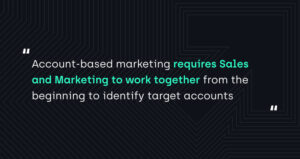Aligning Sales and Marketing
Anyone in either Sales or Marketing knows how difficult it can be to align the two teams, but account-based marketing makes it much easier, and more fulfilling, for both.
So, how does ABM bridge the long-standing divide between Sales and Marketing?
Part 1 and Part 2 of this series, and the Top 3 for Tech Marketers podcast episode with Sangram Vajre, addressed the ability of ABM to humanize B2B marketing. ABM also humanizes the process between Sales and Marketing.
Accounts v. Leads
In a non-ABM sales funnel Marketing focuses on creating demand and capturing leads. Those leads are then passed on to Sales for closing. Marketing gets excited when thousands of users download an ebook or white paper, but Sales is underwhelmed. Why? Because those downloads are Marketing Qualified Leads (MQLs), not Sales Qualified Leads (SQLs). SQLs come with more information; enough information to warrant personalized outreach from Sales. The less information Sales gets from Marketing, the less likely they are to actually close a sale. Lead quality is a significant concern for Sales.
As Vajre pointed out on the podcast, the ultimate responsibility for closing a sale falls to the Sales team, but the onus is on Marketing “to bring the horse to water”. Empathy is essential to aligning the two teams. Vajre suggests one way to create empathy is to have Marketing personnel shadow Sales team members. Sales is extraordinarily difficult, but marketers may not fully grasp that until they spend a day or two alongside their sales counterparts. He also recommends using a Universal Scorecard to eliminate confusion and ensure Sales and Marketing are focused on aligned goals and operating from the same playbook.
The ABM Difference
Account-based marketing requires Sales and Marketing work together from the beginning to identify target accounts, then continue to collaborate on campaign specifics, reporting progress, and ensuring prospects become customers.

Vajre defined ABM as, “Focused B2B marketing. Getting hyper-focused around your list of accounts and the people you care about; people you feel can benefit from your services.” Fully aligned, hyper-focused Sales and Marketing teams are better positioned to create more personalized communications and opportunities. And by being hyper-focused they drive more sales and higher value sales. “At the end of the day, it’s not about more things. It’s about dialing in on the right people and measuring the right things that help make business decisions.” Beyond increased, higher-value sales, ABM enables retention and upselling opportunities after the sale because so much is learned about the account in the acquisition process. Account-based marketing establishes familiarity with an account that can be used to deploy more personalized efforts in the future.
Measuring Engagement
Vajre also addressed the importance of engagement as “the new measurement” and stresses that “a download is not engagement.” If a download isn’t engagement, then what is? “If an account or people within an account are spending time on your site, that’s engagement,” said Vajre. Engagement matters because it’s a predictor of closing a sale and helps clarify where energy should be focused. Which top target accounts have the highest engagement? The answer to that shows where your focus should be. Even if an account is a good potential customer, if their time-to-buy doesn’t fit or they’re not engaged with your company and your value proposition, focus your efforts elsewhere.

ABM: More Than Demand Generation
“We have put marketers in a box when it comes to demand generation,” Vajre said. “… your job is to give me a lead script, pretty website, and show up at an event with a big flyer. And as long as you do that, your job, you’re good.”
Unfortunately, that’s not the best use of a marketing team.
Vajre recommends having Marketing focus on the accounts that have already raised their hand because they’re in an opportunity stage. Focus on them and use the Universal Scorecard so Sales and Marketing can create more personalized experiences for those opportunities. “And what I’ve seen over and over again is then you focus on accounts and then you come up with those personalized things, and show that you care, show that you are human. People will look at you, take notice of it, and buy from you.”
Conclusion
As mentioned in Part 1 of this series, ABM flips the traditional, lead-based sales funnel—Awareness, Interest, Consideration, Purchase—to an account-based funnel of Identify, Expand, Engage, Advocate, Measure. That flip creates a more holistic view of marketing, positioning customer accounts as opportunities for up serving and cross-selling for maximum value. Equally important, account-based marketing humanizes the interaction between Sales and Marketing, as well as a company and customers. As Vajre stated, “It’s not just a tool or something to do. It really is a game-changer and a business driver.”

